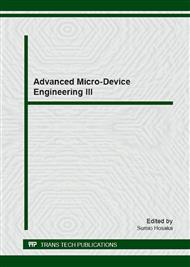p.55
p.61
p.66
p.71
p.76
p.82
p.88
p.93
p.99
Effect of Metal Modification to Carbon Paper Anodes on the Performance of Yeast-Based Microbial Fuel Cells Part Ι: In the Case without Exogenous Mediator
Abstract:
Effect of modification of carbon paper with a thin layer of cobalt or gold on the performance of yeast-based microbial fuel cells was investigated. The modification was conducted by depositing Co or Au thin layer with different thickness, 5 nm and 30 nm, using a sputtering technique. The electrode performance was evaluated by measuring the electrode potentials and the fuel cell power output. The Co modification significantly increased the performance of the fuel cell, while the Au modification inhibited the performance. SEM observation indicated that the adhesion density of the yeast cells on the electrode surface was affected by the metals. It was confirmed that the electron transfer took place through the surface confined species at the mediatorless anode.
Info:
Periodical:
Pages:
76-81
Citation:
Online since:
January 2013
Authors:
Price:
Сopyright:
© 2013 Trans Tech Publications Ltd. All Rights Reserved
Share:
Citation:


